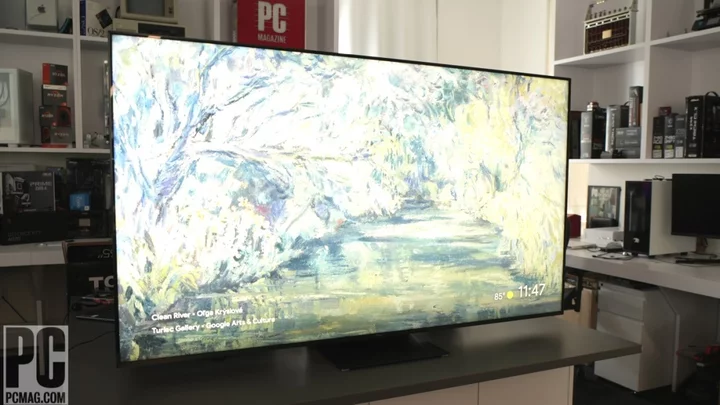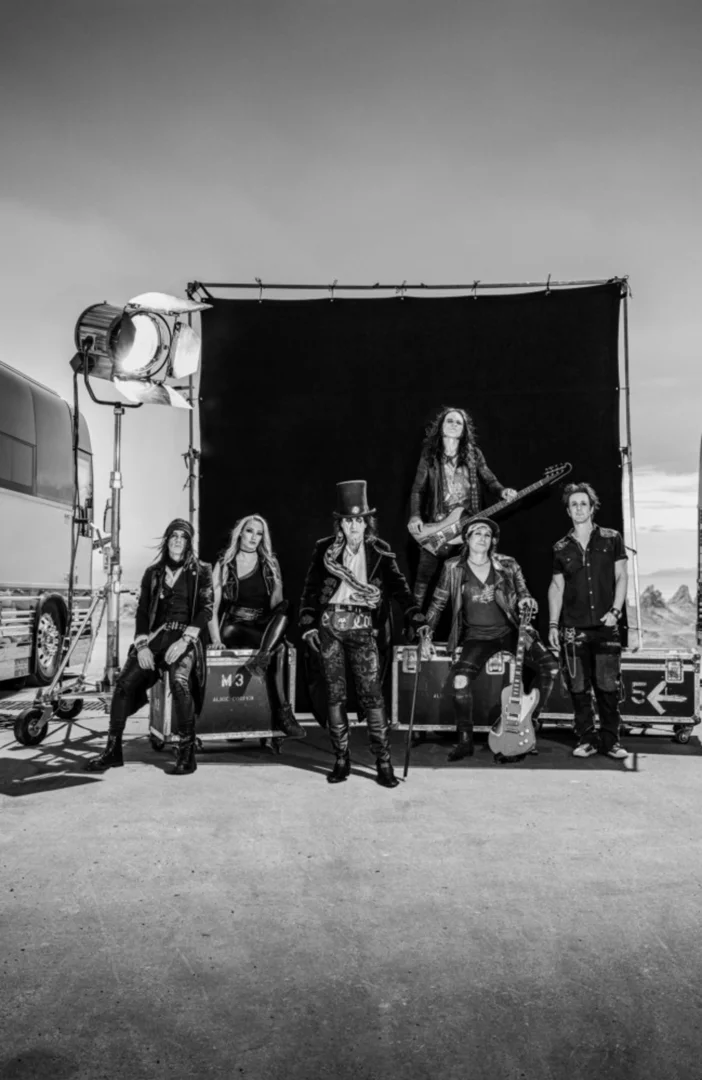The QM8 line serves as a new flagship tier for TCL, with a mini-LED backlight system for an incredibly bright picture and a built-in subwoofer for improved bass response. At $1,699.99 for the 65-inch model we tested, it offers plenty of value for the price and is cheaper than flagship models from other manufacturers such as the Samsung QN95C ($3,299.99 for 65 inches). That said, it doesn't hold quite the same budget-friendly appeal as the previous generation, and that leaves last year's Hisense U8H ($1,399.99 for 65 inches) as our Editors' Choice winner for its price and performance.
Simple and Slim
TCL’s 6-series TVs have consistently represented fantastic values, earning high scores and recommendations for their relatively low prices and excellent performance. TCL is now rearranging its naming conventions, and that includes introducing a new premium model. The 6-series is becoming the Q7 line, while the Q8 is an entirely new line of top-tier sets—something for which TCL isn't necessarily known.
Like the majority of TVs in this price range, the QM8 takes a simple, minimalist design approach. The screen is framed by a thin band of black, brushed metallic material on the top and sides, with a strip running along the bottom edge that features the TCL logo. Below that strip is a rectangular bump that houses the TV’s infrared sensor, far-field microphones, and status LEDs.
The TV sits on a square metal base. It's mounted on a wide plastic support arm that connects the two at an angle. The support arm can be attached to the screen at one of two heights, either close to the base or lifted up a few inches, to accommodate a soundbar. Any soundbar would have to be fairly small to fit below the screen. The TV can also be installed on a wall with a standard VESA mount.
All wired connections apart from the power cable can be found on the right side of the back of the screen, facing right. They include four HDMI ports (one 4K144, one 4K120, one eARC), a USB port, an Ethernet port, an optical audio output, 3.5mm ports for audio output and composite video input, and an antenna/cable connector. The power cable connects to the left side of the TV's rear panel, and both areas have removable plastic doors to guide the cables downward to keep them tidy.
The 20W rear-firing subwoofer is built into the back of the TV. It adds to the bass capabilities of the 10W stereo drivers that cover the rest of the audio range. Enhanced sound systems can certainly improve the listening experience compared with the generally underwhelming speakers found on most TVs, but separate soundbar systems, ideally with a subwoofer and satellites, can provide far more rumble and better directional imaging than any TV can produce on its own.
The remote is long and thin, at 8 by 1.4 by 0.6 inches (HWD). It has a plastic body with rounded edges and a brushed black, almost metallic finish. A circular direction pad sits near the top, with power, input, settings, profile, and voice buttons above it along with a pinhole microphone for Google Assistant. Home, back, and live TV buttons can be found below the pad, with volume and channel rockers further down. Dedicated service buttons for Amazon Prime Video, Apple TV, Netflix, TCL Channel, TCL Home, and YouTube make up the bottom of the button cluster. The TCL Home button stands out because it’s the only non-content button. Pressing it brings up a panel to control any other TCL devices you have that are compatible with the TCL Home app (available for Android and iOS), but those devices already work with Google Assistant, which is also on the TV, so it feels redundant.
Google TV With All the Trimmings
TCL previously offered only Roku TVs before it produced both Roku TVs and Google TVs. The company has now switched entirely to Google TV as the platform for its higher-end TVs while keeping Roku TV for budget models. And so, as TCL’s flagship, the QM8 uses Google TV.
Google TV is a capable smart TV platform that supports most major streaming services, including Amazon Prime Video, Apple TV, Hulu, Max, Netflix, Sling, Twitch, and YouTube for video, along with hundreds of other apps and services for more niche video content, music, health, and even cloud gaming. If you want to stream from a local device, Google TV supports Google Cast for Android smartphones and tablets and Chrome browser tabs. TCL has added Apple AirPlay 2 to the QM8 so you can stream from iPhones, iPads, and Macs as well.
Google Assistant is built into Google TV and thus the QM8. It is accessible by pressing the voice button on the remote and speaking into it, or hands-free via the TV’s far-field microphones using the wake words "Hey Google." Google Assistant is useful and can provide you with general information like sports scores and weather reports, control compatible smart home devices, display live feeds from doorbells and home security cameras, and of course search for content and control the TV directly.
High Contrast and Wide Color
The TCL QM8 is a 4K TV with a 120Hz refresh rate. It supports high dynamic range (HDR) content in Dolby Vision, HDR10, HDR10+, and hybrid log gamma (HLG). It has an ATSC 1.0 tuner for OTA broadcasts, but no ATSC 3.0 tuner for 4K OTA. The lack of an ATSC 3.0 tuner is a surprise, since the QM8 is TCL's top-of-the-line model and a 4K-capable tuner is almost standard future-proofing for TVs at this level.
We test TVs using a Klein K-10A colorimeter, a Murideo SIX-G signal generator, and Portrait Displays’ Calman software. With an SDR signal in Movie mode, the QM8 shows a peak brightness of 627 nits with a full-screen white field and 1,399 nits with an 18% white field. With an HDR signal, those numbers move up to 761 nits with a full-screen white field and 1,620 nits with an 18% white field. However, we noticed an interesting quirk that indicates that the TV can potentially get much brighter: Switching from a full-screen field to an 18% field made the screen’s peak brightness flare up to approximately 2,500 nits for a few seconds before settling in the 1,600-nit range. That’s brighter than any TV we’ve tested, but it’s not a brightness we could consistently measure. Additionally, since the perception of light scales logarithmically, the difference between 1,600 nits and 2,500 nits doesn’t look nearly as significant as, for example, the difference between 200 nits and 600 nits.
With both SDR and HDR signals, we measured black levels of 0.004cd/m^2. That isn’t quite the effectively perfect black level of Samsung’s QN95C micro-LED-lit QLED TV, or any OLED TV, but it’s still extremely low. With little to no visible light bloom and an effective contrast ratio of 405,000:1, the QM8 shows excellent contrast performance. The Hisense U8H actually gets consistently brighter (1,982 nits with an 18% white field), but its contrast ratio is a lower 198,226:1 because of its higher black level (0.01cd/m^2).
The above charts show the TV’s color levels in Movie mode with an SDR signal compared against Rec.709 broadcast standards and with an HDR signal compared against DCI-P3 digital cinema standards. SDR colors are nearly spot-on, with whites leaning slightly cool/magenta. HDR colors are wide and mostly accurate, though magentas run slightly warm, greens drift a bit out of ideal ranges, and yellows are a little undersaturated. These are still strong color measurements, a bit wider and more accurate than the QN95’s but not reaching the virtually perfect HDR color levels of the Samsung S95C ($3,299.99 for 65 inches) or the close-to-perfect color levels of the Hisense U8H.
Disney’s Growing Up Animal: A Baby Grizzly’s Story looks quite natural on the QM8. The bears’ brown fur is appropriately warm, with small textural details coming through. The cool whites of snow are bright, without blowing out the dark bears running through them. The greens of plants are generally realistic, but they can look just a touch cooler than ideal in some shots.
The red of Deadpool’s costume in the overcast opening shots of Deadpool looks vibrant and balanced, with no purplish or faded hues. Later, in the burning lab fight, the flames are bright, with varied yellows and oranges, and shadow details are clearly discernible while staying dark.
The QM8’s strong contrast comes through in The Great Gatsby’s party scenes, where the whites of shirts and balloons look bright against the deep blacks of suits and hair. The cuts and contours of jackets can be seen while staying properly dark, and skin tones appear well-saturated and natural.
Plenty of Gaming Features
Gamers should be pleased with the QM8. It has a native 120Hz refresh rate that can be boosted to an effective 240Hz rate with a Game Accelerator mode that cuts the resolution down from 4K to 1080p in order to refresh the picture twice as fast. It supports variable refresh rate (VRR) with AMD FreeSync Premium Pro, but not Nvidia G-Sync. Its Game Master picture mode also displays a helpful information bar, similar to the Game Bar of Samsung TVs, that shows the status of the current connection and what features are enabled.
Input lag is quite low as well. In Game Master mode, the QM8 shows an input lag of 6.6 milliseconds using an HDFury Diva HDMI matrix, below our 10ms threshold to consider a TV to be best for gaming. The latency is still a bit higher than the Samsung QN95C (2ms), the Roku Plus Series (3.1ms), and a few other models, but it’s still responsive.
TCL's Top TV Comes at a Price
The TCL QM8 offers an excellent picture that’s markedly brighter and has better color than its last-generation 6-series models, but it’s also $700 more (for 65 inches). It’s still far less expensive than some flagship models, like the Samsung QN95C and S95C OLED, but the price is significantly higher than we’ve come to expect from TCL’s top TVs. To be fair, TCL frames the Q7 series as its true follow-up to the affordable 6-series, and the QM8 is intended to be a more premium line. We look forward to testing the Q7 line, which hopefully balances the price-to-performance ratio in TCL's favor. But while the QM8 is an excellent TV in its own right, you're better off saving $300 with the Hisense U8H.









